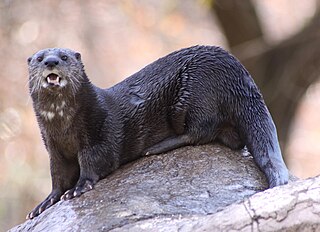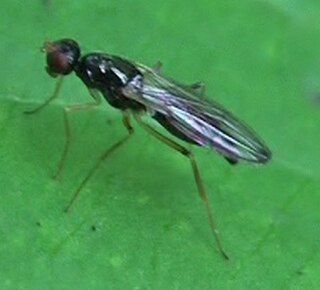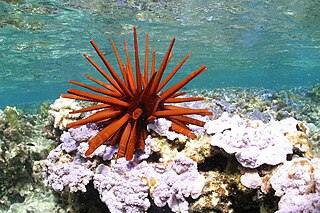
The Diadematidae are a family of sea urchins. Their tests are either rigid or flexible and their spines are long and hollow.

The spotted-necked otter, or speckle-throated otter, is an otter native to sub-Saharan Africa.

The huayco tinamou, also known as waypu (Quechua), is a species of bird found on grassy mountain ridges in the Andes of Bolivia and Argentina.

The Strongylophthalmyiidae are a small family of about 80 species of slender, long-legged flies, the majority of which occur in the Oriental and Australasian regions. They are divided into two genera, the monotypic Southeast Asian genus Nartshukia Shatalkin, 1993 and Strongylophthalmyia Heller, 1902. The relationships of the group are obscure; formerly the genus Strongylophthalmyia was classified with the Psilidae, and some recent classifications place it within the Tanypezidae. Little is known of their biology, but many species seem to be associated with rotting bark.

The Cecidomyiinae are a subfamily of flies often called gall midges or gall gnats. Many are parasitoids or predacious as maggots.

Amblypsilopus is a genus of flies in the family Dolichopodidae. It is a large genus, with about 350 species recorded. However, it is possibly polyphyletic.

Pselliophora is a genus of true crane fly.
Acanthocidaris curvatispinis is a species of sea urchin of the family Cidaridae. Their armour is covered with spines. It came from the genus Acanthocidaris and lives in the sea. Acanthocidaris curvatispinis was first scientifically described in 1892 by Bell.

Acanthocidaris hastigera is a species of sea urchin of the family Cidaridae. Their armour is covered with spines. It is in the genus Acanthocidaris and lives in the sea. Acanthocidaris hastingeria was first scientifically described in 1907 by Alexander Emanuel Agassiz & Hubert Lyman Clark.

Apatopygus recens is a species of sea urchin of the family Apatopygidae. Their armour is covered with spines. It is placed in the genus Apatopygus and lives in the sea. Apatopygus recens was first scientifically described in 1836 by Milne-Edwards, French zoologist.

Clypeaster, common name "cake urchins" or "sea biscuits", is a genus of echinoderms belonging to the family Clypeasteridae.

The Echinometridae are a family of sea urchins in the class Echinoidea.
Aphanopora echinobrissoides is a species of sea urchin of the family Neolampadidae. Their armour is covered with spines. It is placed in the genus Aphanopora and lives in the sea. Aphanopora echinobrissoides was first scientifically described in 1903 by de Meijere.
Aporocidaris antarctica is a species of sea urchin of the family Ctenocidaridae. Their armour is covered with spines. It is placed in the genus Aporocidaris and lives in the sea. Aporocidaris antarctica was first scientifically described in 1909 by Ole Theodor Jensen Mortensen, Danish professor. It has a circum-Antarctic distribution.
Caenopedina indica is a species of sea urchins of the Family Pedinidae. Their armour is covered with spines. Caenopedina indica was first scientifically described in 1903 by de Meijere.

Johannes Cornelis Hendrik de Meijere was a Dutch zoologist and entomologist who specialised in Diptera and Coleoptera.

Goniocidaris is a genus of sea urchins (Echinoidea) in the family Cidaridae and typical of the subfamily Goniocidarinae. Extant species are mostly found in Indo-Pacific seas, often living at depth.

Caenopedina is a genus of sea urchins of the family Pedinidae.
Schistopterini is a tribe of tephritid or fruit flies in the family Tephritidae.

Acanthocidaris is a genus of echinoderms belonging to the family Cidaridae.
















